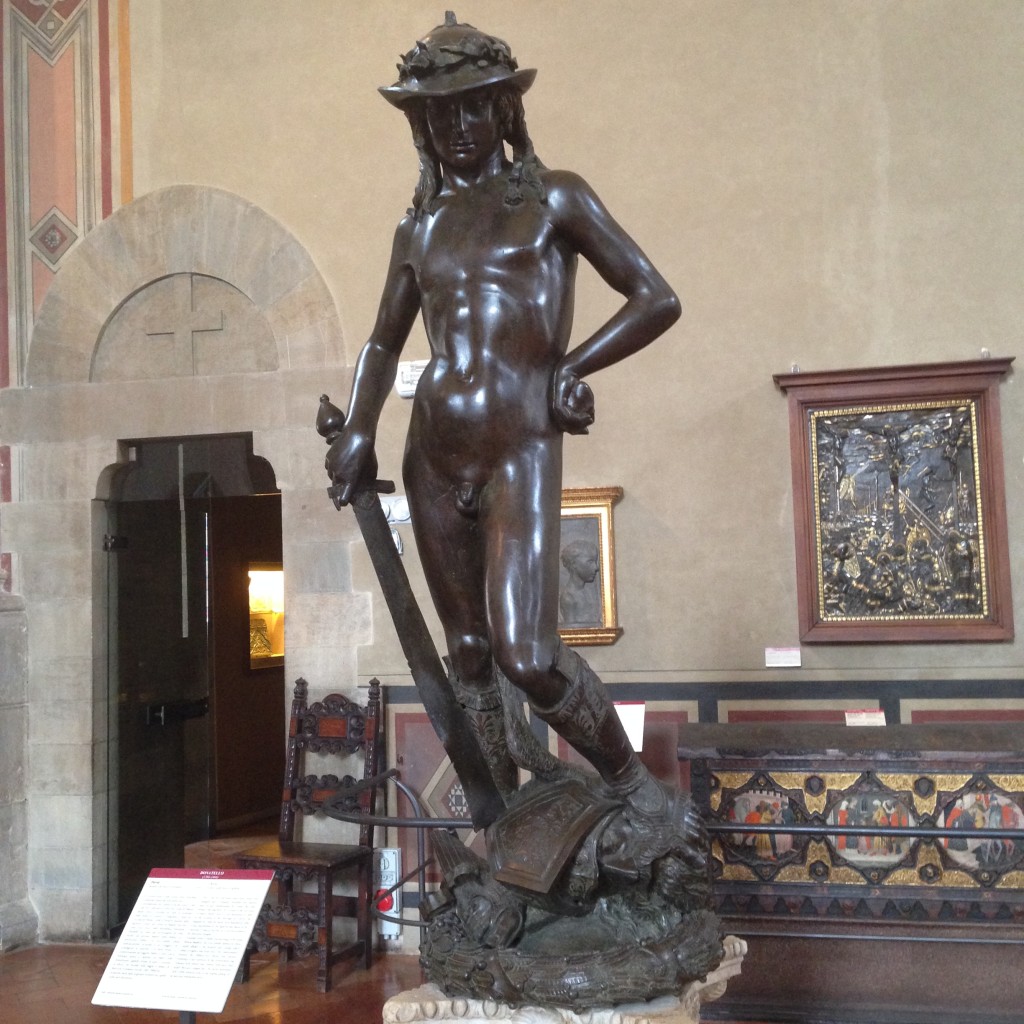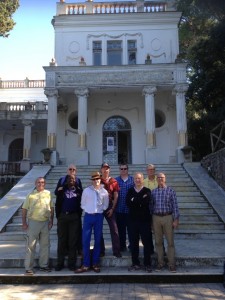
Oscar Wilde Tours has just completed its first full tour in Italy, a ten-day trip that explored an axis of gay cities and sights from Florence to Sorrento, with much time spent in Rome along the way.
In our tours we try to include well-known places that have a gay side most people don’t know about, such as the Campidoglio in Rome, which was of course designed (or redesigned) by Michelangelo—but was also brought to completion after Michelangelo’s death under the direction of Tommaso Cavalieri, the Roman aristocrat for whom Michelangelo wrote many of his love sonnets, and to whom he sent his famous drawing of Jupiter carrying off his boyfriend Ganymede! We don’t know if Michelangelo and Cavalieri were ever lovers, but they certainly had a complex erotic relationship, and finishing the square must have been a kind of gift in return for Michelangelo’s love….
We also take people to places rich in gay history that they never would never have heard of. Here is a photo of our group in front of one of these, the Villa Lysis on Capri. This villa was built in 1905 by the French poet (and steel magnate) Jacques d’Ädelsward-Fersen just below Emperor Tiberius’ Capri palace—where the emperor supposedly carried on his perverted orgies. The two villas share one of Capri’s most spectacular views. Fersen retired here after being put on trial in France for arranging nude or semi-nude tableaux vivants, carried out by boys from Paris’ most prominent lycées. Here Fersen lived for 18 years with his boyfriend, Nino Cesarini—of whom we have nude photos by the early art-pornographer Wilhelm Pluschow, cousin of the more famous Baron von Gloeden—before committing suicide by drinking cocaine dissolved in champagne in his villa’s opium room. Above the group in the cover photo for this post, you can see the villa’s motto, Amori et Dolori Sacrum(sacred to love and pain). What could be more dramatic—or more gay?
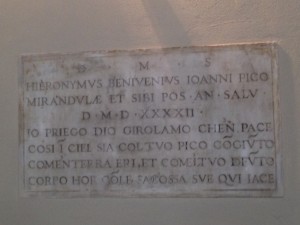
Another fascinating example: the tomb where Girolamo Beniveni had himself buried with Pico della Mirandola. Pico was one of the early humanists, and like his teachers Poliziano and Ficino, a promoter of Plato, and of Platonic love–that is (despite the less precise sense in which the term is used today) intense but unconsummated homosexual love. Pico’s love relationship—consummated or not, no-one is sure—was with his friend Girolamo Beniveni, who was so attached to Pico that he had himself buried with him 48 years after Pico’s death. Last year, we were excited to find tombs in Paris’ Père Lachaise cemetery where gay couples were buried in the 19th century—but here we have a possible gay couple buried together four hundred years earlier!
Although the Italian government is having a hard time getting a civil unions law passed, Italy is a great country for gay history and art. There are monuments and artworks representing several different cultures where same-sex love has played a prominent role.
In the south, for instance, many cities (like Naples) were founded by the ancient Greeks, and several of the best-preserved ancient Greek ruins are in Italy, rather than Greece. We visited one of them, in Paestum, two hours south of Naples, where among other things we saw the Tomb of the Diver, containing the only remaining Greek wall-paintings, which depict male-male courtship, taking place at a drinking party (what the Greeks called a “symposium”). Male-male love revolving around decorous courtship in the gymnasium or at the symposium was typical of Greek culture, but it’s interesting to know that it was typical in Greek Italy as well.
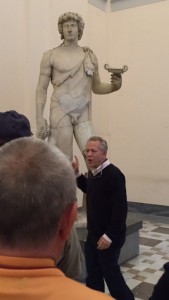 Roman sexual customs were different from Greek ones. Like Greek men, Roman men were free to have sexual relations with younger men; the Romans, however, regarded such relations as shameful for the younger partner, so they could only take place with slaves or foreigners. One of the most famous such relations was between the Emperor Hadrian (86-138 AD) and a young man from modern-day Turkey called Antinous (@111-130 AD). Antinous died at the age of 19; it was probably suicide, possibly in part because he feared he was getting to be too old for his role as a boy toy. But Hadrian did not move on to another boy toy. Instead, he mourned Antinous for the rest of his life, and more than that, he had him made into a god—a privilege usually reserved for emperors and their wives. As a result, Antinous—who is easy to recognize, with his perfect fashion-model looks—is one of the most commonly represented people in all of Roman art. And on our tour we ran into him everywhere. Here, for instance, I am talking to the group in front of a statue of Antinous, portrayed as Bacchus.
Roman sexual customs were different from Greek ones. Like Greek men, Roman men were free to have sexual relations with younger men; the Romans, however, regarded such relations as shameful for the younger partner, so they could only take place with slaves or foreigners. One of the most famous such relations was between the Emperor Hadrian (86-138 AD) and a young man from modern-day Turkey called Antinous (@111-130 AD). Antinous died at the age of 19; it was probably suicide, possibly in part because he feared he was getting to be too old for his role as a boy toy. But Hadrian did not move on to another boy toy. Instead, he mourned Antinous for the rest of his life, and more than that, he had him made into a god—a privilege usually reserved for emperors and their wives. As a result, Antinous—who is easy to recognize, with his perfect fashion-model looks—is one of the most commonly represented people in all of Roman art. And on our tour we ran into him everywhere. Here, for instance, I am talking to the group in front of a statue of Antinous, portrayed as Bacchus.
We saw a lot of Renaissance and later art in Rome and Naples, but ancient cultures still dominated our time in these cities.
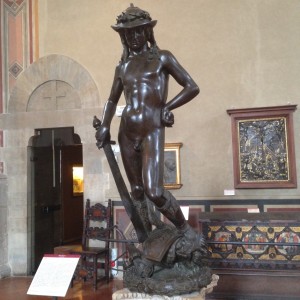
When we got to Florence, however, the Renaissance took over the stage. We saw statues like Donatello’s David, made in 1408-9—and the first free-standing nude since ancient times. And what a nude! Instead of portraying David as a tough kid, Donatello makes him as effeminate as he can, with long curly hair and swaying hips—and just look at the feather from Goliath’s helmet disappearing between David’s thighs! A strange way to portray a Biblical hero, no? We talked a lot about the culture of male-male love in Renaissance Florence (on which there is a surprising amount of evidence in the city’s court records) and saw many homoerotic artworks from the period, making clear just how gay the Florentine Renaissance was.
In short, there was gay history and art all around us, as well as generally beautiful cities and artworks, plus great food. Not a bad way to spend 10 days….
Gay Italy’s 2016 departure will be announced soon! Keep an eye on Oscar Wilde Tours webpage for updates. And check out its gay history and art tour of Greece, May 20-29, 2016.


